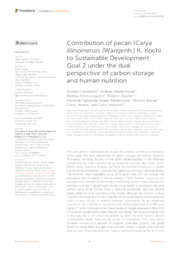Contribution of pecan (Carya illinoinensis [Wangenh.| K. Koch) to Sustainable Development Goal 2 under the dual perspective of carbon storage and human nutrition.
Contribution of pecan (Carya illinoinensis [Wangenh.| K. Koch) to Sustainable Development Goal 2 under the dual perspective of carbon storage and human nutrition.
Author(s): CAMBARERI, G.; FRUSSO, E. A.; HERRERA-AGUIRRE, E.; ZOPPOLO, R.; LEITE, F. F. G. D.; BELTRÁN, M.; MARTINS, C. R.; MENDOZA, C.
Summary: This work aims to contextualize and analyze the potential contribution of pecan to SDG2 under the dual perspective of carbon storage and human nutrition. Particularly, the study focuses on the pecan agroecosystems in the Americas, representing the most important pecan-producing countries (the United States, Mexico, Brazil, Argentina, Uruguay, and Peru). We observed that pecan is a reliable sink for storing atmospheric C and also for quality nuts with high nutritional density. The Americas, hold a population of ca. 23 M pecan trees, with the younger tree populations and the highest C-storing potential in South America. This pecan tree population has removed 51.3 Mt CO2eq immobilizing the OC in their aboveground biomass, but if the C sequestration for the whole system is considered, the value reaches nearly 80 Mt CO2eq. From a nutritional perspective, there are different dietary needs to cover according to the country, although the common analysis output is a low proportion of nuts in the diet, which is expected to improve, given the efforts of each country to promote domestic consumption. All the mentioned countries in this study have a low pecan consumption going from 8 to 293 g per capita yr-1, which in the light of the Global Burden of Disease represents 0.08 to 3.2% of the recommended yearly dietary basis for nuts overall. The inclusion of pecan nuts in the daily diet is of utmost importance to offset the food nutrient dilution carbohydrates-based, linked to the excess of atmospheric CO2. Also, pecan orchards function as a platform to integrate sustainable systems. The global benefit of having pecan and alley crops has been proved in regions other than the Americas with interesting economic outputs leading to energizing the life of rural communities. Pecan orchards and pecan agroforestry may lead to sustainable agri-food systems, with global gains in SOC and nutritional richness and diversity. Therefore, more in-depth studies are needed not only to fully understand the functioning of the systems at a productive level but also to design and plan sustainable landscapes in rural land.
Publication year: 2023
Types of publication: Journal article
Keywords: Carbono, Carya illinoensis, Noz, Noz Peca, Nutrição, Nutrição Humana
Observation
Some of Embrapa's publications are published as ePub files. To read them, use or download one of the following free software options to your computer or mobile device. Android: Google Play Books; IOS: iBooks; Windows and Linux: Calibre.
Access other publications
Access the Agricultural Research Database (BDPA) to consult Embrapa's full library collection and records.
Visit Embrapa Bookstore to purchase books and other publications sold by Embrapa.

